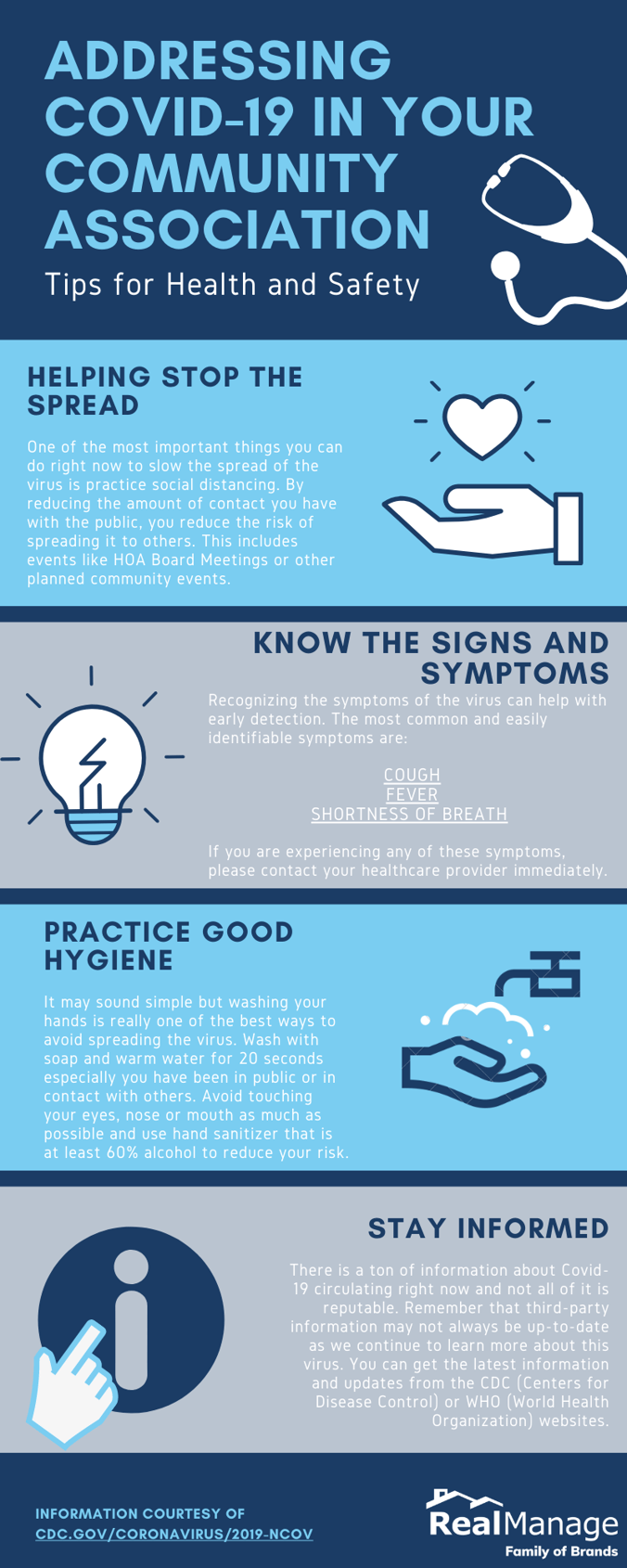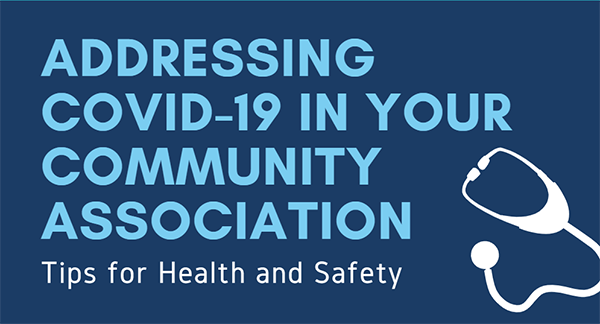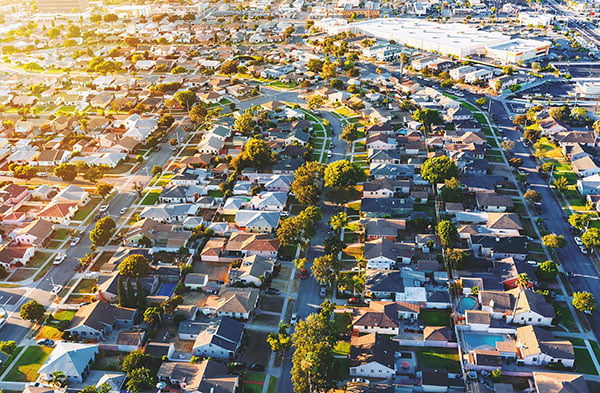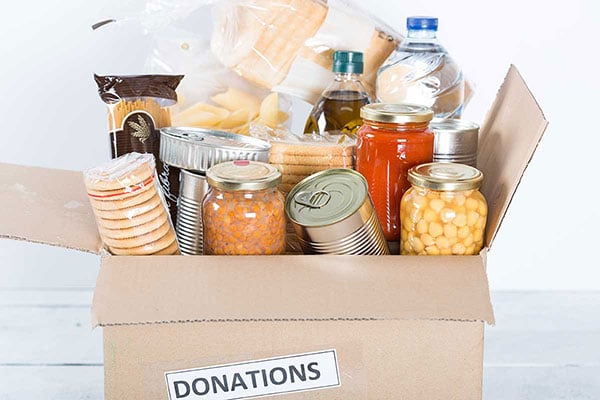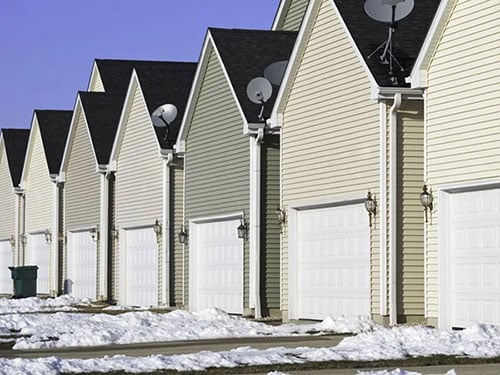*The following article is meant to help community association leaders by providing some plans and information about handling Covid-19 (also known as the Novel Coronavirus or Sars-Covid-2) and is not meant to be a full emergency plan or provide health care advice. Please continue checking with primary sources (such as the CDC or WHO) for more immediate and fully up-to-date information.
As COVID-19 outbreaks are appearing more and more in the news it's important that your community and the board members take every precaution to help reduce the spread of this virus. An outbreak could last for weeks or even months in your community. This can be especially true for those communities with communal spaces like elevators or shared gated entry systems. Depending on the severity of the outbreak, public health officials may recommend community actions to reduce spread of COVID-19. Local public health officials may make recommendations appropriate to your local situation, such as flexible sick-leave and telework policies and temporary school dismissals.
Planning and Preparing for an Outbreak
There are steps that you and your fellow board members can take before an outbreak to ensure that your community is as prepared as possible for not only a viral emergency but in any emergency or national disaster.
Establish ongoing communication with your local public health department to facilitate access to relevant information before and during an outbreak.
Having a good contingency plan in place and developing flexible policies and procedures to accommodate public health recommendations can help reduce infection. During your planning process, remember to engage key partners across both public and private sectors, such as local businesses, schools, other community- and faith-based organizations, and community leaders. Also, the specific details of your plan should be based on the extent of the outbreak and the size of your organization and workforce, complexity of your day-to-day operations, and type of on-site and off-site services your organization provides to vulnerable populations.
Connect to community-wide planning.
Find out if your local government has a private-public emergency planning group that meets regularly. Building strong alliances before an outbreak may provide your organization with the support and resources needed to respond effectively. Also, in recognition of the “whole community” approach to emergency planning and management, your input as community leaders and stakeholders helps ensure the completeness and representativeness of your local government’s emergency operations plan.
Putting Your Plans into Action
Stay informed about the local COVID-19 situation. Get up-to-date information about local COVID-19 activity from public health officialsexternal icon. Be aware of temporary school dismissals and company closures in your area because these may affect your board members and volunteers. Those communities with many elderly, at risk individuals may need to suspend meetings and community events until further notice.
Communicate frequently with those in your communication chain. Update key community partners and stakeholders regularly. Share information about how your organization is responding to the outbreak. Be open with homeowners who are concerned with how they can help and ensure that everyone in your management team is aware of their role in the coming weeks.
Provide information that explains why and when on-site operations and services may be temporarily scaled back or your organization may be closed to non-essential visitors. Some community administrators and leaders may choose to alter normal operations due to high staff absenteeism. Meet with your emergency operations coordinator or planning team to discuss plans for modifying, scaling back, postponing, or canceling large group activities and events (e.g., community picnics or planned maintenance), especially for high-risk groups like the elderly. Discuss how these actions will impact your organization and those you serve.
Distribute health messages and materials to staff, volunteers, and the community. Continue to promote everyday preventive actions (e.g., stay home when sick, cover coughs and sneezes, and wash hands often). Offer resources that provide reliable COVID-19 information. Address the potential fear and anxiety that may result from rumors or misinformation.
Provide COVID-prevention supplies to staff, volunteers, and those you serve. Ensure that your organization has supplies, such as hand sanitizer that contains at least 60% alcohol, tissues, trash baskets, and disposable face masks for staff, volunteers, and those you serve if you do plan on hosting an in-person meeting. Clean frequently touched surfaces and objects daily (e.g., tables, countertops, light switches, doorknobs, and cabinet handles) using a regular detergent and water.
Address the concerns of board members, homeowners and volunteers who are at high risk for COVID-19 complications. Encourage staff and volunteers to consult with their healthcare provider about how to protect their health if they are at high risk for COVID-19 complications. Be prepared to address the health concerns and needs of those who are at high risk, such as older adults and those with underlying health conditions.
Implement flexible attendance and sick-leave policies (if possible) due to COVID-19. Ask staff (and volunteers) to stay home if they are sick to lower their chances of spreading illness to others, or if caring for a sick household member. Provide instructions about how and when to safely return to work.
Separate those who become sick at your organization from those who are well. Send sick members and volunteers home immediately. If someone you serve becomes sick at your organization, separate them from others (particularly from those who are at high risk for COVID-19 complications) as soon as possible. Work with the local public health department and nearby hospitals to care for those who become sick. If needed, arrange transportation for staff and others who need emergency care. If you are interested you can read more about caring for those sick with COVID-19.
